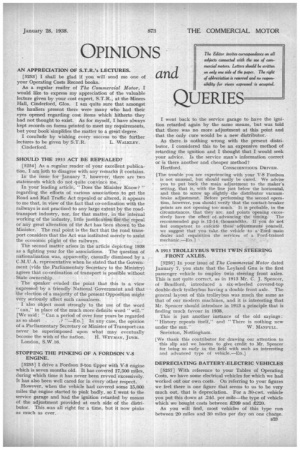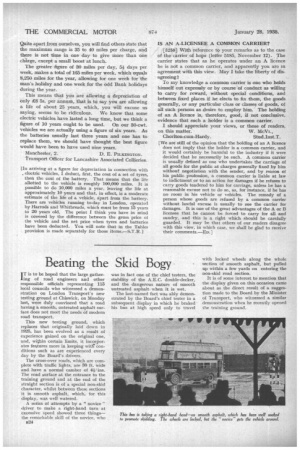OPINIONS and UERIES
Page 27

Page 28

If you've noticed an error in this article please click here to report it so we can fix it.
AN APPRECIATION OF S.T.R.'s LECTURES. [5253] I shall be glad if you will send me one of your Operating Costs Record books.
As a regular reader of The Coreariereierl Motor, I would like to express my appreciation of the valuable lecture given by your cost expert, S.T.R., at the Miners Hall, Cinderford, Glos. I am quite sure that amongst the hauliers present there were many who had their eyes opened regarding cost items which hitherto they had not thought to exist. As for myself, I have always kept records on forms printed to meet my requirements, but your book simplifies the matter to a great degree.
I conclude by wishing every success to the further lectures to be given by S.T.R. L. WALKLEV. Cinderford, SHOULD THE 1933 ACT BE REPEALED?
[5254] As a regular reader of your excellent publication, I am loth to disagree with any remarks it contains.
In the issue for January 7, however, there are two statements which do not quite convince Me.
In your leading article, "Does the Minister Know? " regarding the efforts of various associations to get the Road and Rail Traffic Act repealed or altered, it appears to me that, in view of the fact that co-ordination with the railways is not practised to any large extent by the roadtransport industry, nor, for that matter, in the internal working of the industry, little justification kr-the repeal or any great alteration of the Act has been shown to the Minister. The real point is the fact that the road transport considers that the Act was instituted merely to assist the economic plight of the railways.
The second matter arises in the article depicting 1938 as a fighting year for the associations. The question of nationalization was, apparently, casually dismissed by a C.M.U.A. representative when he stated that the Govern: inent (vide the Parliamentary Secretary to the Ministry) agrees that co-ordination of transport is possible without State ownership. The speaker evaded the point that this is a view expressed by a friendly National Government and that the election of a majority of the present Opposition might very seriously affect such casualness.
I also object most strongly to the use of the word can," in place of the much more definite word "will." [We said : Can a period of over four years be regarded as so short . .? "—ED.]. In any case, the opinion of a Parliamentary Secretary or Minister of Transport can never be superimposed upon what may eventually
become the wish of the nation. H. WEYMAN, jUNR. London, S.W.16.
STOPPING THE PINKING OF A FORDSON V-8 ENGINE.
[5255] I drive a Fordson 3-ton tipper with V-8 engine which is seven months old. It has covered 17,500 miles, during which time it has never been revved excessively. It has also been well cared for in every other respect.
However, when the vehicle had covered some 15,000 miles th,e engine started to pink badly, so I went to the service garage and had the ignition retarded by means of the adjustment provided at each side of the distributor. This was all right for a time, but it now pinks as much as ever. I went back to the service garage to have the ignition retarded again by the same means, but was told that there was no more adjustment at this point and that the only cure would be a new distributor.
As there is nothing wrong with the present distributor, I considered this to be an expensive method of retarding the ignition and I thought that I would seek your advice. Is the service man's information correct or is there another and cheaper method?
Hertford. CONSCIENTIOUS DRIVER.
[The trouble you are experiencing with your V-8 Fordson is not unusual, but should easily be cured. We advise you to put back the main adjustment to the maker's setting, that is, with the line just below the horizontal, and then to screw up slightly -the distributor vacuumbrake adjustment. Before performing the second operation, however, you should verify that the contact-breaker points are not opening too much. It is probable, in the circumstances, that they are, and points opening excessively have the effect of advancing the timing. The recommended gap is 12-14 thousandths, If you do not feel competent to execute these adjustments yourself, we suggest that you take the vehicle to aFord .main dealer and requisition the services of a Ford-trained mechanic;—En.}
A 1913 TROLLEYBUS WITH TWIN STEERING ,FRONT AXLES.
[5256] In your issue of The Commercial Motor dated January 7, you state that the Leyland Gnu is the first passenger vehicle to employ twin steering front axles. This is not quite correct, as in 1913 Mr. C. J. Spencer, of Bradford, introduced a six-wheeled covered-top double-deck trolleybus having a double front axle. The general layout of this trolleybus was much the same as that of our modern machines, and it is interesting that Mr. Spencer should introduce in 1913 a principle that is finding much favour in 1938.
This is just another instance of the old sayings : "History repeats itself," and "There is nothing new under the sun." W. MANFULL. Sneinton, Nottingham.
[We thank this contributor for drawing our attention to this slip and we hasten to give credit to Mr. Spencer for being so early in the field with such an interesting and advanced type of vehicle.—En.]
DEPRECIATING BATTERY-ELECTRIC VEHICLES [5257] With reference to your Tables of Operating Costs, we have some electrical vehicles for which we had worked out our own costs. On referring to your figures we feel there is one figure that seems to us to be very much out, that is depreciation. For a 30-cwt. vehicle you put this down at .24d. per mile—the type of vehicle which we bought costs between £209 and £220.
As you will find, most vehicles of this type run between 20 miles and 30 miles per day on one charge. B23 Quite apart from ourselves, you will find others state that the maximum range is 35 to 40 miles per charge, and there is not time in one day to give more than one charge, except a small boost at lunch.
The greater figure of 30 miles per day, 51 days per
week, makes a total of 165 miles per week, which equals 8,250 miles for the yeas, allowing for one week for the man's holiday and one week for the odd Bank holidays during the year.
This means that you are allowing a depreciation of only £8 5s. per annum, that is to say you are allowing a life of about 25 years, which, you will excuse us saying, seems to be ridiculous. We know that some electric vehicles have lasted a long time, but we think a
figure of 10 years ought to be used. On our 30-cwt. vehicles we are actually using a figure of six years. As the batteries usually last three years and one has to replace them, we should have thought the best figure would have been to have used nine years.
Manchester, 2. I). E. PILKINGTON.
transport Officer for Lancashire Associated Collieries.
[In arriving at a figure for depreciation in connection with , electric vehicles, I deduct, first, the cost of a set of tyres, then the cost of the battery. That means that the lifs allotted to the vehicle is roughly 100,000 miles. It is possible to do 10,000 miles a year, leaving the life at approximately 10 years and that, in effect, is a moderate estimate of the life of a vehicle, apart from the battery. There are vehicles running to-day in London, operated by Harrods and Whitbreads, which must be from 15 years to 20 years old. The point I think you have in mind is covered by the difference between the gross price of the vehicle and the net price when tyres and batteries have been deducted. You will note that in the Tables provision is made separately for those items..—,S.T.R.1
IS AN A-LICENSEE A COMMON CARRIER?
[5258j With reference to your remarks as to the case of the carrier of hops (letter 5185, November 12). The carrier states that as he operates under an A licence
he is not a common carrier, and apparently you are in agreement with this view. May I take the liberty of disagreeing?
To my knowledge a common carrier is one who holds himself out expressly or by course of conduct as willing to carry for reward, without special conditions, and between fixed places if he elects to fix them, the goods generally, or any particular class or classes of goods, of all such persons as desire to employ him. The holding of an A licence is, therefore, good, if not conclusive, evidence that such a holder is a common carrier.
I should appreciate your views, or those of readers, on this matter. W. McVr., Choriton-cum-Hardy. Stud.Inst.T.
[We are still of the opinion that the holding of an A licence does not imply that the holder is a common carrier, and it would certainly be harmful to the industry if it were decided that he necessarily be such. A common carrier is usually defined as one who undertakes the carriage of all goods for the public at charges generally fixed by him without negotiation with the sender, and by reason of his public profession, a common carrier is liable at law to indictment or to an action for damages if he refuses to carry goods tendered to him for carriage, unless he has a reasonable excuse not to do so, as, for instance, if he has no room in his vehicle or vehicles. The remedy of a person whose goods are refused by a common carrier without lawful excuse is usually to sue the carrier for damages. It is one of the great advantages of the A or B licensee that he cannot be forced to carry for all and sundry, and this is a right which should be carefully guarded. It may be that others of our readers disagree with this view, in which case, we shall be glad to receive their comments.—En.}
































